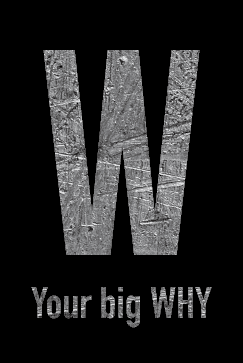Earlier this year I released a Handbook and Video Series called ATHLETE TOUGH™. This project came about because I wanted athletes to understand that qualities such as mental toughness, resilience and grit were in fact teachable skills. Mental toughness is not a mythical quality some are born with and others without.
The term ATHLETE TOUGH™ describes just this – a person’s mental skills or toughness – and the process of becoming ATHLETE TOUGH™ can be learned and taught through a series of proven strategies. In ATHLETE TOUGH™, the Handbook and Video Series, we define what the term is and more importantly we give you the strategies you need to behave this way.
 This article delves into what it means to be ATHLETE TOUGH™. I want to pass on a key factor in becoming ATHLETE TOUGH™ and that is finding your purpose. Or what I also refer to as “Your Big Why”.
This article delves into what it means to be ATHLETE TOUGH™. I want to pass on a key factor in becoming ATHLETE TOUGH™ and that is finding your purpose. Or what I also refer to as “Your Big Why”.
This is the key to toughness.
In my experience, when I have noticed an athlete or corporate employee behaving in a ‘tough’ way, the commonality was related to the strength of their drive. How much they wanted to achieve something, how willing they were to perform to high expectations, meet someone else’s demands or fulfill a dream. The toughness they displayed was a result of their motivation to achieve something which meant a great deal to them. Put simply, when our motivation is at this high level, we generally find a way to “get it done”. A strong sense of motivation is the fundamental factor in behaving in a tough way.
Before I discuss the concept of ATHLETE TOUGH™ further, I want to talk about grit. Lately we have heard a lot about ‘grit’. Grit is a massive theme in every performance environment and recognized as a number one contributor to success, so I feel it is natural for people to think such an important quality must only be possessed by elite soldiers, athletes or entrepreneurs and that most “normal” people do not have ‘it’. But this could not be further from reality. What I have noticed is that most of us have displayed high-performance levels of grit, toughness or resilience in our lives, even if only for periods of time.
So, I am not interested in who has or has not got grit, because we all do, in the right circumstances and environmental conditions. And this is what is most important to understand. The circumstances where toughness emerges are those where we can pursue our true purpose or achieve our greatest sense of meaning or contribution. When people operate in these conditions, I believe most of us are inspired to give our maximal effort and crash through or strategically deal with whatever obstacles are put in front of us. So I’ll say it again – finding your “Big Why” is the key to toughness.
Through various studies, I have discovered that 80% of the outcome is determined by knowing “why” you want to achieve the outcome in the first place. The more deeply attached to the reason “why” and what it means to you, the more likely it is you will give your best effort to make it happen.
I remember when I first dreamt of being an Olympian. There was nothing I wanted to do more at the time. It was not a passion nor a high-level interest, it was much more than that and it needed to be. My reasons why I wanted to be an Olympian were associated with the sense of achievement, the need for status (I had never won a race at school or felt what it was like to truly achieve at a great level) and to prove to many doubters that I could do “anything”. For me, this formed my ‘Big Why’. When you have a big reason WHY, it becomes very easy to prioritize your choices in life. For me, there was nothing I would rather be doing that rowing a boat or participating in something associated with being better at rowing a boat. That made it easy to say no to friends who asked me to head out, party, even career choices and study which did not seem relevant at the time – I could pass it all up without a second thought.
Becoming an Olympian when I was only 18 was not a struggle in the sense of having to manage competing demands. I am not saying the practices were easy, they were not. But it was easy to get myself pumped up for them and to stay focused on my goal.
But, my situation of finding something that captivated me like rowing did is perhaps not normal. In fact, having been retired from rowing for three Olympic cycles (12 years), and after co-establishing a company from ground zero, my perspective on being tough has changed. And the fact is that over time our toughness can soften unless we continually challenge ourselves and push ourselves out of our comfort zone. Often our sense of purpose goes missing, we become distracted and lose sight of our ‘Big Why’ and the result is that our motivation to continue to test our pain threshold waivers. It is during these times, which no doubt you can relate to as well as I can whether they be in sport or business, that we need quality toughness strategies we can call on to rediscover our path and rekindle our motives. Recalling my rowing practices helped me in my sporting career and in my business and working life. That’s because, no matter the scenario, to succeed we need focus points or short term technical / measurable goals so that we can stay on task in any situation without succumbing to an environment which is full of distractions or obstacles. And because we need to be able to call on these practices quickly, we need to have practiced them. Keep in mind however, many environmental conditions are often outside of your Circle of Control and as such, the best we can do is to adapt to new conditions through effective toughness strategies.
Factors which make non-ideal environments include, Coach or manager relationship issues, issues with team members, technology which is not functioning correctly creating frustration, illness and injury, others doubting you and being negative, the list continues. To be tough in these times is what truly makes someone ATHLETE TOUGH™.
In previous articles, I have spoken about the Navy SEALs toughness strategy. They use a four-part process consisting of short terms goals, positive self-talk, visualizing success and the ability to manage your emotions through quality breathing strategies and keeping perspective. This strategy alone improves your toughness. A lot of my work though has been to identify how other behaviors are exhibited by really tough people.

As well as having a big reason WHY, tough people do not see their tough behaviors as “behaviors”. Toughness is not just something they do. It is more about who they are and how toughness defines them as a person. Toughness becomes their identity. When you say, “I am tough” that is a statement which reflects who you are, not just what you do. Tough people identify themselves as such. Tough people have a bank of experiences they constantly refer to which gives them their sense of a tough identity. For example, before a challenging situation, the first step they take is to think back to a time where they met the challenge and created a great outcome. This reinforces their sense of identity and reminds them they can cope with whatever is thrown their way. This even includes new experiences that do not have strict links to exact past experiences, they just know their toughness will see them prevail. Toughness is inherent in who they are and how they do what they do.
Tough people are rapid reframers. Reframing is about changing (reframing) the meaning of something. When we have an experience we automatically associate or attach a meaning to the experience. So, when we reflect or describe the experience we may describe it as positive, negative, great, poor, etc. If someone else was to have your exact same experience, they may attach an entirely different meaning to it. This is what happens when a Coach gives really direct feedback to a player. One player might say, “great, this means I now know what to do better,” another player says, “the Coach seems upset and that must mean I am not doing very well so I may be benched soon and that means…” The point is what meaning we attach to something is totally our choice. It is just that most of us may not be aware of what meaning we are attaching and this is especially an issue when the meaning we attach is negative. Being able to reframe is not about attaching a purely positive meaning but instead it is about attaching a “useful” meaning. A useful meaning is a productive meaning. For example, let’s say you just lost a game. A useful reframe to this is finding a learning outcome such as “when we lose it must mean we need to improve in some way, so how can we get better,” instead of it meaning, “we should give up as we are obviously not good enough.” Common reframes are failure – learning, why – how, I can’t – what can I do. When I raced, if a crew was in front of me at the half way mark, I learnt to see that as an opportunity to finish well. I would say it meant they must have spent a lot of energy to get in front and if I push now, I will break them over the next 1000 meters. It may take 999 meters but I will get in front.

One last factor that develops tough people is the environment they have practiced, grown up in or been associated with for a long period. The phrase, “the advantage of disadvantage” is relatively well known now. What this is referring to is how we as Coaches or managers can make “life” too easy for our athletes or employees. Some Coaches or managers make life comfortable by doing things for their athletes or employees in the belief it will help them. But the opposite happens. The more we try to make life more comfortable for others, the more we “disable” the development of toughness. The lifeblood of toughness is discomfort. Note I said discomfort not unsafe. Coaches and managers who do too much for their athletes and people do them a disservice. Same for parents who sort out all their children’s problems. It does not work in producing resilient or tough people who can cope with life’s challenges. Read more about this in our article on Coaching Millennials.
This article takes our previous articles a step further with more strategies and ideas of what works in developing toughness or resilience. Remember the most critical part to appreciate is how we all have toughness in us…we just have to exercise it and link it to who we are and try to pursue activities which are meaningful for us. Of course we have to face challenges and environmental conditions which are unfavorable, but just imagine how you will feel when you rise to these challenges and achieve your best.
Read more about becoming ATHLETE TOUGH™ here.
Why Your big reason ‘WHY?’ Better Be A Good One
The drive to train, perform and continually improve is common to elite athletes in every sport. Sometimes it’s present in talented athletes, sometimes it’s not, but it can be developed. One mechanism that athletes can lever, is their reason for doing what they do, or their big reason WHY.







